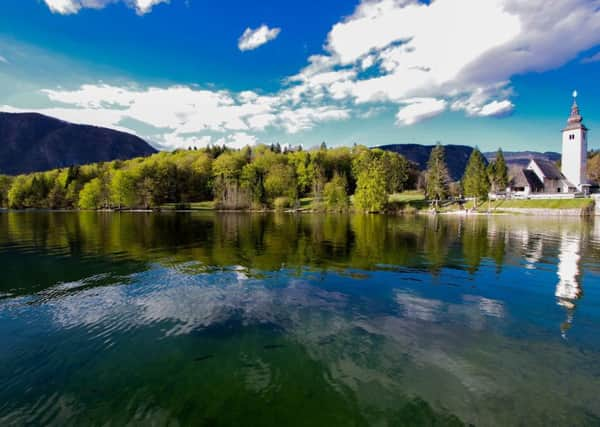Travel review: Slovenia - a treasure trove of natural beauty


What would a dream holiday scene look like to you? For me, there would be trees, mountains, water and unspoilt natural landscape.
Slovenia, I recently discovered, has this in spades – but I didn’t just get to stop and look at the view, I stepped into it. Well actually, I paddled into it, standing up, a little wobbly-kneed at first, on a floating board.
Advertisement
Hide AdAdvertisement
Hide AdIf you haven’t yet tried stand-up paddle-boarding, or SUP as it’s also known, chances are, it won’t be too long before you do. It may be far gentler than surfing, but SUP’s really gathering pace in the popularity stakes, and it turns out Slovenia is the perfect place to do it.
Almost 60 per cent of this small south-eastern European country (you can drive from one side to the other in a few hours) is tree-covered, and while Slovenia only has 30 miles of coastline – it’s more or less one giant bay in the Adriatic Sea, tucked between Croatia and the Gulf of Venice – the land itself boasts 17,000 miles of rivers, streams and lakes.
Traditionally, paddleboards are inflated manually, requiring a fair bit of elbow-grease, which is fine if it’s just one board; not so fine if there’s a group of you.
“It was paddleboarding with my kids that inspired the designs,” says SipaBoards founder Sebastjan Sitar. “It would take ages to pump up boards for the whole family. Our boards inflate in seconds, with zero effort.”
Advertisement
Hide AdAdvertisement
Hide AdThe addition of motorised engines was another family-inspired brainwave, after Sebastjan’s young daughter struggled to paddle back to shore one day. Operated via a switch at the top of the paddle, the motor doesn’t exactly propel you along full-pelt, but the extra momentum certainly helps when you’re up against winds or currents.
We start with a paddle along Ljubljanica River, which runs through Ljubljana. It only takes a couple of minutes to get used to standing on the boards, then off we go, sailing past the capital city’s historical streets and under bridges, glancing up at the castle’s belvedere tower.
It’s a novel way to take in the sights, and Ljubljana also makes a great base for exploring more of the country. We stay at the Antiq Hotel, perfectly situated a stone’s throw from the river, pretty squares and coffee shops.
Right now, Ljubljana – along with the whole of Slovenia – is relatively quiet, but it’s easy to see the appeal. It takes little over two hours to fly here from the UK, but I immediately feel like I’ve been transported somewhere far further.
Advertisement
Hide AdAdvertisement
Hide AdAn essential stop on every itinerary is Lake Bled, in the Julian Alps, overlooked by the medieval Bled Castle and made instantly recognisable by the tiny island that sits just off-centre, boldly sprouting a cluster of bushy trees, old buildings and a 170ft-high church tower.
Less well-known than Bled, but not to be missed, is Lake Bohinj. While Bled has the picture-postcard charm, Bohinj really draws the gasps; it is utterly dreamy.
Active holidays aren’t just a great way to see a country – working up a sweat means you can really indulge on the food front too. We treat ourselves to some fine-dining at Vila Podvin (four miles from the centre of Bled) and sample outstanding seafood at AS Aperitivo and RiziBizi (both in the capital).
Slovenia is also the only European country which connects the Alps, the Mediterranean and the Pannonian Plain, and our jaunt to the coast highlights that this little country really is a land of vast geographical contrasts.
Advertisement
Hide AdAdvertisement
Hide AdMountain peaks and alpine forests give way to lush pastures, olive groves and vineyards, and the temperature cranks up a good few degrees as we make the hour-and-a-half drive from Ljubljana to Secovlje.
The coast has a real Mediterranean feel, and you can paddle-board off the beach when the water’s calm enough, or explore near the Secovlje salt flats, where salt is still produced using 700-year-old traditional methods.
After a morning on the boards, we ditch our paddles for a stroll around Piran, an old coastal town that’s all painterly narrow streets and pretty squares, bordered by dazzling blue sea and bobbing fishing boats.
Our trip ends with a visit to Kamnik, an unassuming little town nestled among some of the most breathtakingly stunning countryside I’ve ever seen. We only have time for a short hike, but you don’t have to venture far to lose yourself among the forests, shimmering rock faces and bright turquoise streams.
Advertisement
Hide AdAdvertisement
Hide AdThis is the true beauty of Slovenia: it has everything, and all of it’s nearby.
GETTING THERE
Wizz Air operates four weekly flights to Ljubljana from Luton, from £18.49 one-way. Visit wizzair.com.
SUP trips can be organised independently (from around 150 euros per day) while ready-made SUP tour packages are available through Bananaway Stand Up Paddle Tours, ranging from two-hour tours on Ljubljanica (35 euros) to bespoke five-day tours. For info, visit slovenia.info.
Double rooms at Antiq Hotel start from 120 euros per night (antiqhotel.eu).